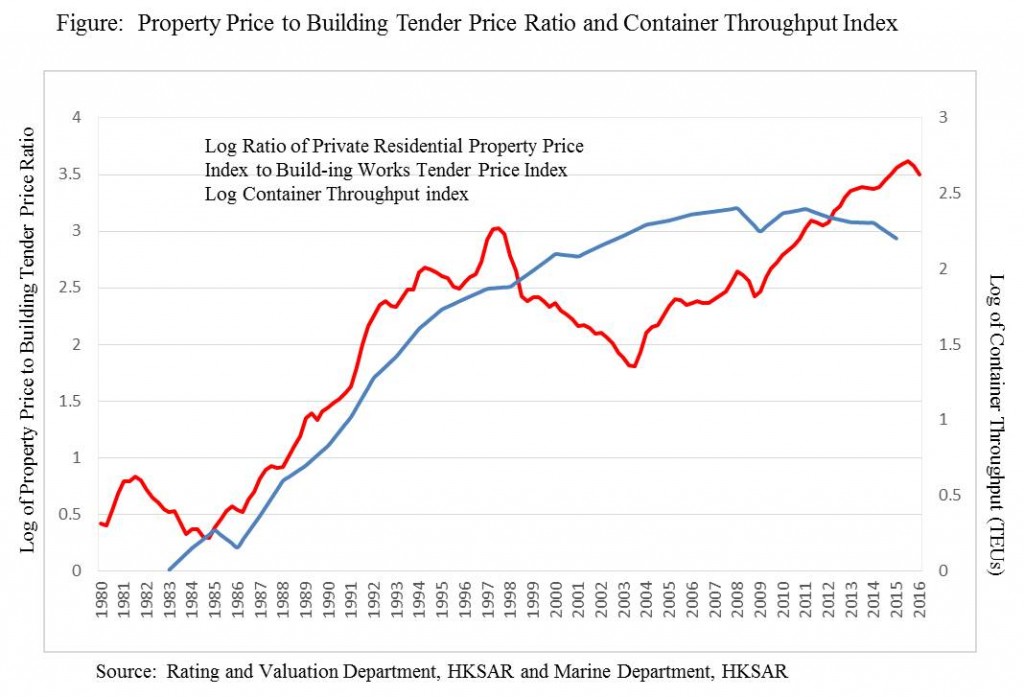(This essay was published in South China Morning Post on 28 September 2016.)
Why have property prices risen steadily since 1984, punctured only by the Asian financial crisis and the ensuing recession of 1997-2003?
There are three explanations. First, demand has been driven by business cycles abroad, including Fed policy, mediated primarily through their effects on interest rates and exchange rates.
Second, China’s opening has produced two demand effects. One is the structural shift away from manufacturing into services, which inflated the prices of domestically consumed services (including residential property prices), the other is the increased demand from the inflow of immigrants through cross border marriages and the rising wealth of mainland buyers.
Third, the slow process of land development and housing construction has reduced housing supply growth. There are two interpretations as to why that has happened.
One is the populist view that blames “government-developer-landlord” cronyism. This is a charge advanced by a growing number of opposition politicians. This explanation is unconvincing because it depends on rising cronyism and proving why it has risen over time and whether its timing coincides with rising housing prices.
Another view is that planning and building regulations have delayed development and housing supply. Such regulations have grown and become more onerous over time.
The opening up of the political system has introduced more uncertainty into the development process as interest groups take advantage of more demanding regulations to delay the decision making process.
Hong Kong is not alone in seeing its housing supply affected by regulation. Harvard economics professor Edward Glaeser was the first to identify planning and building delays as the most important cause of the delayed supply of housing. He demonstrated that restrictive regulation constrains the supply of housing so that increased demand leads to much higher prices, not many more units.
This pattern is found in all the high price housing markets across the United States, but not in somewhere like Tokyo, where housing prices have not grown in 20 years. Tokyo adopts a laissez-faire approach to land use that allows lots of construction, subject to only a few general national regulations. As a result, in 2014 there were 142,417 housing starts there compared with 83,657 in the entire state of California and 137,010 in the entire United Kingdom.
In contrast, housing supply in Boston is not keeping up with demand. In the 1960s, there were 172,459 new units permitted in the Boston metropolitan area; and in the 1980s, 141,347. However, despite the sharp rise in prices in the 1990s, only 84,105 new units were permitted in that decade.
Glaeser showed that from 1996 to 2006 (when the US market experienced a long housing price boom), easy credit accounted for no more than one-fifth of the rise in house prices and that it was regulatory rigidities in development and housing supply that were the most significant factors contributing to housing bubbles.
In Hong Kong, the slow conversion and redevelopment of industrial buildings, increasing hostility towards higher plot ratios due to environmental concerns, and against constructing public rental housing estates because of a “not-in-my-backyard” (NIMBY) mindset have all slowed down housing supply growth.
In the New Territories, where most of the undeveloped lands in Hong Kong are located, the redevelopment of agricultural land has been under comprehensive planning control since 1991.
However, such redevelopment depends on agreement between rural landlords, property developers, and rural squatters (who have been living on agricultural land with some engaged in farming activities). The involvement of government officials in the negotiation almost guarantees the process will be drawn out for years if not decades. Most of the lands are also small fragmented plots that make negotiation even more complicated. The interests of different stakeholders are difficult to align through negotiations alone.
With such diverse interests, there is a “tyranny of the status quo” in the New Territories, which has been made more difficult by the rising value of agricultural land put to alternative uses, such as storage for containers, parking and collection sites for recycled products. The figure shows that the excess percentage gap of residential property prices above construction costs soared within a short few years after the number of container boxes discharged at our terminals started to takeoff in the mid-1980s.
Since 1997, society’s focus has been on finding someone to blame for high and rising residential property prices. Given that only half the population owns property, this will always be a politically charged issue – restrict supply and prices soar, relax supply and prices collapse – can there be a winning strategy?
The real challenge is to find another strategy that would lower regulatory costs in order to get out of this situation quickly for otherwise political polarization will exacerbate.



